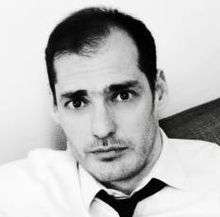Régis Campo

Régis Campo, born in Marseille in 1968, is a French composer.[1]
Biography
He studied composition with Georges Boeuf at the Conservatory of Marseille. Then he entered the Conservatoire de Paris in the classes of Alain Bancquart and Gérard Grisey, where he obtained his first composition prize in 1995. In 1992 he studied with Edison Denisov who considered him as “one of the most gifted of his generation.” His style, often described as playful and colorful, departs the great aesthetic trends of the late twentieth century with emphasis on melodic invention and tempos of great vitality.
From 1999 to 2001 he was resident at the Villa Medici. In Europe and around thirty countries around the world, many artists have played his music.
His work has received numerous awards including the Gaudeamus Prize (1996), the Special Award Young Composers (1996), the Dutilleux Prize (1996), SACEM prices Hervé Dujardin (1999) and Pierre Cardin (1999) The Institute of France, the SACEM Prize for Young Composers (2005), the “Georges Bizet” Prize of the Institute of France (2005), Prize of the Simone and Cino Del Duca Foundation (2014).
In 2001, his work Lumen, for orchestra, is created by the Berkeley Symphony Orchestra under the direction of Kent Nagano, California, in April 2003, the same performers become successful with the creation of his First Symphony. In November 2003, Felicity Lott and the Ensemble Orchestral de Paris, conducted by John Nelson, created Happy Birthday at the Théâtre des Champs-Élysées. She also created his Bestiary after Apollinaire with the Orchestre National de France under the direction of Alain Altinoglu in November 2008 in Dijon and Paris. His CD “Pop-Art” received the Academy Charles Cros “coup de cœur” in 2005. His Second Symphony “Moz’art” was created in September 2005 by the Ensemble Orchestral de Paris under the direction of John Nelson at the opening of its 2005-2006 season at the Théâtre des Champs-Elysées. The Orchestre symphonique de Montréal conducted by Kent Nagano has created in 2008 in Montreal his orchestration of Erik Satie Sports and divertissements.
His second opera “Quai ouest” based on the play by Bernard-Marie Koltès was created in September 2014 at the Strasbourg Opera House during the Festival Musica, then given back during the 2014-2015 season in German language at the National Theatre in Nuremberg (Staatstheater Nürnberg).
His catalog – containing over two hundred works – comprises various instrumental or vocal ensembles as: Commedia (1995) for 19 musicians, the Chamber Concerto for 7 musicians (1996), the Violin Concerto (1997- revised 2001), the Livre de Sonates (1997-1999) for organ, the Piano Concerto (1998-1999), Nova (1999) for 12 mixes voices, mixes choir and ensemble, the Livre de Fantaisies for cello (1999), Faërie (2000-2001) for orchestra, Happy Bird (2001) concerto for flute, 2 horns, percussion and string orchestra, Lumen (2001) for orchestra. Premier Livre (2000-2002) for piano, Pop-art (2002), Symphony no 1 (2002–2003) for orchestra, Ouverture en forme d’étoiles (2004) for orchestra, String Quartet no 1 “Les Heures maléfiques” (2005), Symphony no 2 “Moz’art” (2005) for orchestra, String Quartet no 2 (2006), String Quartet no 3 “Ombra felice” (2007), Lumen 2 (2006-2013), Le Bestiaire after Apollinaire for soprano and orchestra (2007-2008), Les Quatre Jumelles, opera buffa for 4 singers and 9 instruments (2008), String Quartet n°5 ” Fata Morgana” (2012), Quai-ouest, opera (2013-2014).
Catalogue
His catalogue – comprising over a two hundred works – covers various instrumental and vocal formations
References
- ↑ Campo, Régis. The Living Composers Project 4 April 2005. Retrieved 17 July 2011.
External links
- "biography" (in French). IRCAM.